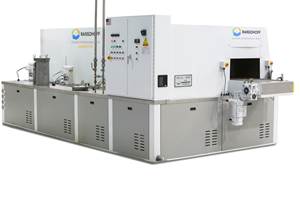Cleaning Tests That Don’t Cost Much
Before you call the lab, try simple, cost-effective tests to screen product for unwanted contaminants.
“What I’d really like to have is a wealthy person’s approach to cleaning tests, but on a pauper’s budget,” requested an attendee at PMTS/PCx in Columbus, Ohio.
Analytical testing is costly; it is often time consuming, and the answer may not be useful. We know of no test that is an absolute guarantee of a clean surface. Sometimes, sending a sample to a lab for analytical tests is the most direct way to solve a contamination problem. Before you call the lab, try simple, cost-effective tests to screen product for unwanted contaminants. Here are a few examples.
Look at the surface under standard conditions. “Standard conditions” are the kind of lighting or magnification that gives the most informative view of the surface, and then these conditions are used continually to look at the product.
Look at the surface using white light and using a “black” UV light; some contaminants fluoresce. Use a digital microscope and take photographs. What do you see? Does the surface look oily? Can you see particles?
Drop water on the surface. Put a drop of water on a freshly waxed automobile. It beads up, indicating an organic (oily) residue. In the water break test, a drop that spreads smoothly indicates a clean surface unless fine particles or surfactants remain and interfere. Contact angle tests allow users to assign a number to the degree of beading. A new, low-cost approach to contact angle measurement uses simple equipment and the camera on a phone.
Make the dirt easy to see. Maybe it’s hard to see the dirt. A “white glove” test involves wiping down the part and looking at the glove or wiper. Use clear tape to lift dirt off the surface. Do you see metal fines? Oil? Particles of lapping compound?
What if the dirt is stuck in blind holes and helicoils; what if the dirt is so diffuse that you can’t see it? Look in the mirror. Labs use phrases like “extractive analysis.” Extraction is a fancy term for removing soils from the surface by “washing” it with pure water or solvent (the extraction solution).
There are three provisos in extraction. First, manage all chemicals safely. Keep flammable solvents away from heat and combustion sources. Second, use extracting liquids that are residue-free. Aqueous cleaning agents are likely to leave interfering residue. Third, select extraction fluids that pick up the soils of interest. Water is not effective to pick up oil. Test more than one extraction fluid.
Place many small parts in a container with the extraction solution, and then slosh them around. An ultrasonic tank can simplify and standardize the sloshing process. With large parts, you might have to repeatedly run the solution over the surface.
Concentrate the wash solution by evaporation, and deposit the concentrate onto a clean mirror for final drying. Observe the residue on the mirror. Is it oily? Powdery? Are there particles? Maybe you can identify the particles as metal fines, skin flakes or fabric fibers. Further processing by gravimetric or chemical analysis may quantify the amount and identity of the residue.
The key to performing cost-effective tests is critical thinking and observation. Document everything so that it can be repeated. It may give clues to the nature and source of the contaminant. Test product with an acceptable surface; there will probably be some detectable soil residue. Compare the results with interfering soils.
Most companies have a limited budget. The request for a cost-effective, wealthy person’s approach to testing was from an employee of a major American manufacturing corporation. Large and small companies need to find effective and affordable methods to test the quality of their product. Stay tuned for pointers on how basic detective work can help identify potential contaminants and reduce the need for or reduce the cost of complex tests.
Related Content
Meeting Stringent Cleaning Goals With Modular Ultrasonic System
A knee implant manufacturer implements an advanced cleaning system that meets its tight cleaning requirements, including documenting, validating and tracing the entire cleaning process.
Read MoreEnvironmentally Friendly Model 550 Versatile Parts Washer
PMTS 2023: This washer is useful in a variety of applications, including tool rooms, maintenance operations, low production and precision cleaning.
Read MoreMultisolvent 100 Vacuum Vapor Degreaser Provides Contactless Cleaning
PMTS 2023: With applications in the most demanding industrial sectors, the machine is especially useful for cleaning parts in the turning, precision mechanics, medical and aerospace industries.
Read MorePMTS 2023 Product Preview: Parts Cleaning
Learn about some of the latest parts cleaning solutions that will be on display at PMTS 2023.
Read MoreRead Next
Do You Have Single Points of Failure?
Plans need to be in place before a catastrophic event occurs.
Read MoreA Tooling Workshop Worth a Visit
Marubeni Citizen-Cincom’s tooling and accessory workshop offers a chance to learn more about ancillary devices that can boost machining efficiency and capability.
Read MoreEmerging Leaders Nominations Now Open
Here’s your chance to highlight a young person in your manufacturing business who is on the path to be a future leader moving your company forward.
Read More






















